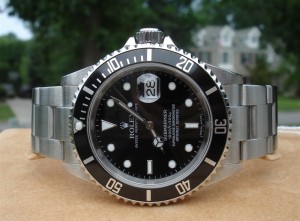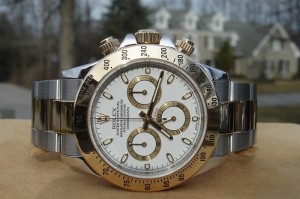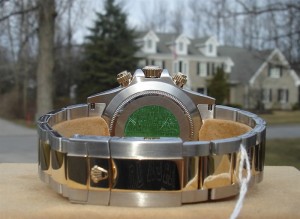Let’s imagine if you stumbled upon a vintage Omega Speedmaster with “Gemini 7” engraved on the caseback during your late night eBay surfing,. You might stop and guess, “Oh, why?” Well, a sharp-eyed Hodinkee reader found something just as (potentially) perfect. A US-based eBay seller has quietly posted – alongside a jade elephant pendant, a set of three Elgin pocketwatches, and some other bits and bobs – a Rolex Submariner replica watch. The gilt four-line dial printing, lovely patina and riveted bracelet would make it a nice find for any collector. But this may not be any ordinary vintage Sub. On the caseback is engraved, “SEALAB-13”, which possibly ties this iconic diving watch to one of the most famous, and motivated, of man’s early attempts to live at the bottom of the ocean. 
While most public attention in the 1960s was given to the dueling American and Soviet space programs, the US Navy was putting men into an equally difficult and alien environment, under the guise of the “Man in the Sea” SEALAB program. Astronauts were fighting for control of the high ground of the heavens at the same time, the Navy saw the ocean floor as the next frontier. The only way to truly obtain a foothold below the waves was to enable humans to live there for extended periods, with ambitions of colonies and workplaces, and of course for defense purposes. After all, this was during the height of the Cold War. But living underwater, at even relatively shallow depths, is fraught with complication and danger.
Two more SEALAB missions were conducted, with the second at 205 feet of depth off of La Jolla, California. SEALAB II had hot showers and refrigeration, and former Mercury astronaut turned aquanaut, Scott Carpenter, remained submerged for a record 30 days. Flush with the success of this second mission, SEALAB III, launched in February of 1969, was to be the most ambitious of all, at a depth of 610 feet with a slew of planned experiments. But when the habitat developed a leak on the first day, divers were sent down to solve the problem. One of them, aquanaut Berry Cannon, died of acute hypoxia, due to his rebreather lacking the key ingredient for removing carbon dioxide from his breathing gas. Rumors of sabotage swirled, and the successful Moon landing mere months later, as well as the public’s general lack of interest in undersea habitation, caused the SEALAB program to be deleted. 

For those of us interested in watches, particularly replica watches, SEALAB has become legend for its role in the development of arguably the most purpose-built watch ever made—the Rolex Sea-Dweller. Chief Warrant Officer, Robert A. Barth, the only aquanaut to take part in all three SEALAB missions, famously approached a fake Rolex rep at a trade show, complaining about the fact that the crystal of his Submariner was popping off during the divers’ long decompression cycles. The answer, of course, was a helium release valve, which could evacuate the built-up helium inside the watch. But the Sea-Dweller wouldn’t be developed until SEALAB III, so for the first two missions, most of the divers wore Submariner.